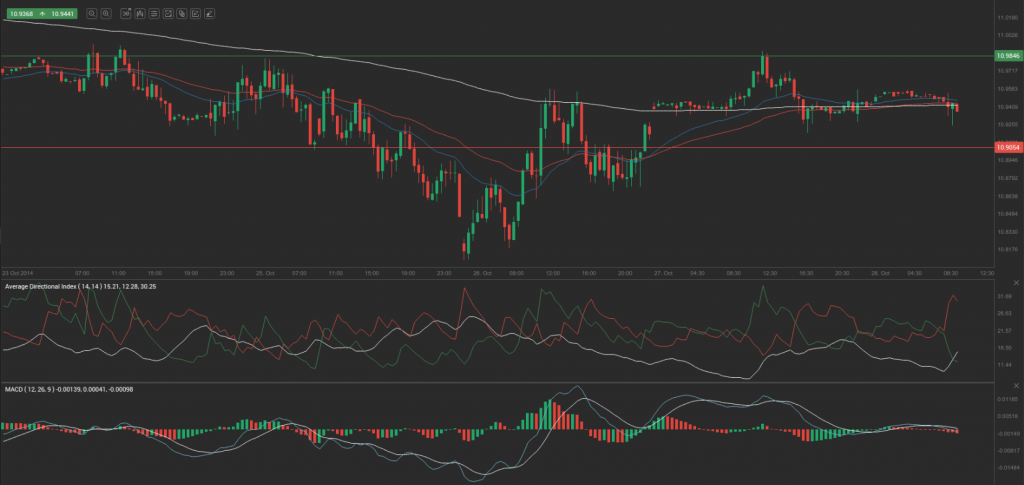Yesterday’s trade saw USD/ZAR within the range of 10.9160-10.9953. The pair closed at 10.9398, losing 0.05% on a daily basis.
At 8:18 GMT today USD/ZAR was up 0.08% for the day to trade at 10.9429. The pair touched a daily high at 10.9585 at 2:45 GMT.
Fundamentals
United States
Orders for durable goods
Durable goods orders in the United States probably rose 0.6% in September compared to a month ago, according to the median forecast by experts. In August new orders for manufactured durable goods dropped at a pace of 18.4%, a revision down from an 18.2% drop previously, to reach USD 245.4 billion USD. Excluding defense, new orders fell 19.0% in August. Transportation equipment, also down, following two consecutive monthly increases, was the main driver behind the overall decrease, with orders falling 42.0% to reach USD 76.8 billion, according to data by the US Census Bureau. Inventories of manufactured durable goods, up during sixteen of the last seventeen months, rose 0.4% to USD 403.0 billion in August. Non-defense new orders for capital goods decreased 36.3% to USD 86.8 billion during the same month.
Durable goods orders, as an indicator, gauge the strength of US manufacturing sector and represent a major portion of nations factory orders. This is a closely watched report on manufacturing activity, because durable goods are the first type of goods to be affected by an economic downturn or upturn.
Durable goods are designed to last three or more years and encompass aircraft, automobiles and buses, cranes, machine parts, appliances etc. More than 85 industries are represented in the sample, which covers the entire United States. The logic behind this indicator is that consumers need to be very optimistic in order to buy an automobile in comparison with, for example, first necessities such as food or clothing. Therefore, durable goods are among the first goods, which a consumer may abstain from purchasing, in case overall economic activity begins to contract. The same is valid for company purchases. During a recession, an airliner is less likely to purchase new planes and as factory output contracts, it is less likely to purchase new machines.
Durable goods orders, which exclude transportation, probably rose 0.5% in September, following a revised down 0.4% increase in August (0.7% gain previously). Large ticket orders, such as automobiles for civil use or aircraft, are not present in the calculation, as their value may be in a wide range. This way the index provides a more reliable information in regard to orders of durable goods.
In case orders increased at a faster pace than projected, this would certainly have a bullish effect on the greenback. US Census Bureau is scheduled to release the official numbers at 12:30 GMT.
Consumer confidence index by the CB
Confidence among consumers in the United States probably slightly improved in October, with the corresponding index coming in at a reading of 87.0 from 86.0 in September. The latter has been the lowest value since June, when the index stood at 85.2.
This indicator measures the level of individuals confidence in the US economic activity. It is considered as a leading indicator, as it gives an early insight into consumer spending, which accounts for most of the nations GDP. Confidence is measured on a scale of -100 to +100. A reading of -100 implies a lack of confidence, while a reading of 100 is indicative of extremely high confidence. Zero values imply neutrality. In case the index improved more than anticipated, this might provide support to the US dollar, as higher confidence suggests greater willingness to spend and, respectively, accelerated economic growth. The Conference Board research group is to publish the official index reading at 14:00 GMT.
South Africa
The rate of unemployment in South Africa probably remained steady at 25,5% during the three months to September, according to expectations. The rate was reported at 25,2% during the first quarter of the year. Between the first and the second quarter of the year, the number of unemployed people in South Africa rose by 87 000 to reach 5.2 million, or the highest level since the inception of the Quarterly Labor Force Survey in 2008. Compared with 2013, the number of unemployed persons rose by 182 000 during the second quarter of the year. At the same time, employment increased by 39 000 in Q2, mostly due to an increase of 60 000 jobs in private households and 43 000 jobs in the informal sector, according to the report by Statistics South Africa.
The unemployment rate represents the number of unemployed people relative to the labor force in the country. It is generally considered as a leading indicator for the economy, as rising rates suggest the labor market is not faring well given the current economic conditions and vice versa. Therefore, higher rates of unemployment suggest a slack in the economy and are deemed bearish for the rand, while a lower unemployment suggests economic expansion and, as a result, a stronger national currency. The official rate is due out at 9:30 GMT.
Pivot Points
According to Binary Tribune’s daily analysis, the central pivot point for the pair is at 10.9504. In case USD/ZAR manages to breach the first resistance level at 10.9846, it will probably continue up to test 11.0297. In case the second key resistance is broken, the pair will probably attempt to advance to 11.0640.
If USD/ZAR manages to breach the first key support at 10.9054, it will probably continue to slide and test 10.8711. With this second key support broken, the movement to the downside will probably continue to 10.8261.
The mid-Pivot levels for today are as follows: M1 – 10.8486, M2 – 10.8883, M3 – 10.9279, M4 – 10.9676, M5 – 11.0072, M6 – 11.0469.
In weekly terms, the central pivot point is at 10.9862. The three key resistance levels are as follows: R1 – 11.0523, R2 – 11.1722, R3 – 11.2383. The three key support levels are: S1 – 10.8663, S2 – 10.8002, S3 – 10.6803.






